Fractal Characterization of the Microstructure of Red-Bed Soft Rocks and Kinetic Modeling of Interfacial Evolution
Abstract
1. Introduction
2. Materials and Methods
2.1. Material
2.2. Test Procedures
3. Results
4. Discussion
4.1. Quantitative Analysis of Microscopic Interfacial Damage in Soft Rock
4.2. Three-Dimensional Fractal Dimension of Red-Bed Soft Rock Fracture Structure
4.3. Analysis of Interface Evolution
4.4. Kinetic Modeling of Microscopic Interfacial Evolution in Red-Bed Soft Rock
5. Conclusions
Author Contributions
Funding
Institutional Review Board Statement
Informed Consent Statement
Data Availability Statement
Acknowledgments
Conflicts of Interest
References
- Guery, A.A.; Cormery, F.; Shao, J.F.; Kondo, D. A micromechanical model of elastoplastic and damage behavior of a cohesive geomaterial. Int. J. Solids Struct. 2008, 45, 1406–1429. [Google Scholar] [CrossRef]
- Deng, H.F.; Zhou, M.L.; Li, J.L.; Fang, J.C.; Xiao, Y.; Zhang, H.B.; Wang, C.X. Mechanical properties of red-bed soft rock under water-rock interaction. Chin. J. Rock Mech. Eng. 2016, 31, 3481–3491. [Google Scholar]
- Zhu, J.J. Study on Water-Rock Mechanism and Time-Dependent Deformation Characteristics of Red Beds Soft Rock in Central Yunnan. Ph.D. Thesis, Chengdu University of Technology, Chengdu, China, 2019. [Google Scholar]
- Zhou, C.Y.; Peng, Z.Y.; Shang, W. On the key problem of the water-rock interaction in geoengineering: Mechanical variability of special weak rocks and some development trends. Rock Soil Mech. 2002, 23, 124–128. [Google Scholar]
- Liu, Z.; He, X.; Zhou, C. Influence Mechanism of Different Flow Patterns on the Softening of Red-Bed Soft Rock. J. Mar. Sci. Eng. 2019, 7, 155. [Google Scholar] [CrossRef]
- Zhao, Z.; Liu, H.; Lyu, X.; Wang, L.; Tian, Z.; Sun, J. Experimental Study on the Damage and Deterioration Behaviour of Deep Soft Rock under Water-Rock Interaction. Geofluids 2021, 2021, 8811110. [Google Scholar] [CrossRef]
- Yan, L.; Liu, P.; Peng, H.; Kašanin-Grubin, M.; Lin, K. Laboratory study of the effect of temperature difference on the disintegration of redbed softrock. Phys. Geogr. 2019, 40, 149–163. [Google Scholar] [CrossRef]
- Chen, H.; Ji, W.; Zhang, S. The principle of diffusion chronology and its application in the study of magmatic systems. J. Rock Sci. 2022, 38, 1499–1511. [Google Scholar]
- Liu, C.; Liu, X.L.; Zhang, D.; Wu, C.; Wang, E.; Wang, S. The water-rock interface dynamic model of soft rock softening and its evolution law. J. Geotech. Eng. 2022, 44, 2280–2289. [Google Scholar]
- Yao, W.; Li, C.; Zhan, H.; Zhou, J.-Q.; Criss, R.E.; Xiong, S.; Jiang, X. Multiscale Study of Physical and Mechanical Properties of Sandstone in Three Gorges Reservoir Region Subjected to Cyclic Wetting–Drying of Yangtze River Water. Rock Mech. Rock Eng. 2020, 53, 2215–2231. [Google Scholar] [CrossRef]
- Zhou, C.; Cui, G.; Yin, H.; Yu, L.; Xu, G.; Liu, Z.; Zhang, L. Study of soil expansion characteristics in rainfall-induced red-bed shallow landslides: Microscopic and macroscopic perspectives. PLoS ONE 2021, 16, e0246214. [Google Scholar] [CrossRef]
- Zhou, C.Y.; Liang, N.; Liu, Z. Multifractal characteristics of pore structure of red-bed soft rock in water. J. Eng. Geol. 2020, 28, 1–9. [Google Scholar]
- Zhang, Z.H.; Wei, W.; Zhang, J.; Jia, H. Determination method of pore multi-scale fractal dimension of red sandstone based on CT scanning. Geol. Technol. Bull. 2022, 41, 254–263. [Google Scholar]
- Mandal, P.; Sarout, J.; Rezaee, R. Triaxial Deformation of the Goldwyer Gas Shale at In Situ Stress Conditions-Part II: Viscoelastic Creep/Relaxation and Frictional Failure. Rock Mech. Rock Eng. 2023, 56, 7441–7474. [Google Scholar] [CrossRef]
- Huancollo, H.J.M.; Saboya, F.; Tibana, S.; McCartney, J.S.; Borges, R.G. Thermal Triaxial Tests to Evaluate Improvement of Soft Marine Clay through Thermal Consolidation. Geotech. Test. J. 2023, 46, 579–597. [Google Scholar] [CrossRef]
- Alekseev, A.; Bezvolev, S. Evaluation of Creep Indicators of Plastic-Frozen Soil According to Laboratory and Field Tests. Soil Mech. Found. Eng. 2023, 60, 86–92. [Google Scholar] [CrossRef]
- Jaiswal, M.; Sebastian, R.; Mulaveesala, R. Detecting meso-damage and subsurface cracks in a hard rock using frequency-modulated thermal wave imaging. Meas. Sci. Technol. 2024, 35, 035403. [Google Scholar] [CrossRef]
- Mandelbrot, B.B. Les Object Fractals: Forme, Hasard et Dimension; Flammarion: Paris, France, 1975. [Google Scholar]
- Hewage, S.A.; Tang, C.-S.; Mehta, Y.; Zhu, C. Investigating cracking behavior of saline clayey soil under cyclic freezing-thawing effects. Eng. Geol. 2023, 326, 107319. [Google Scholar] [CrossRef]
- Du, J.; Whittle, A.J.; Hu, L.; Divoux, T.; Meegoda, J.N. Coupling grid nanoindentation and surface chemical analysis to infer the mechanical properties of shale mineral phases. Eng. Geol. 2023, 325, 107304. [Google Scholar] [CrossRef]
- Chen, L.; Liu, T.; Jia, B.; Tang, J.; Liu, J. Acoustic emission and fractal characteristics of red beds soft rock under water-force coupling. Sci. Rep. 2024, 14, 4423. [Google Scholar] [CrossRef] [PubMed]
- Zhang, G.; Ling, S.; Liao, Z.; Xiao, C.; Wu, X. Mechanism and influence on red-bed soft rock disintegration durability of particle roughness based on experiment and fractal theory. Constr. Build. Mater. 2024, 419, 135504. [Google Scholar] [CrossRef]
- Ulusay, R.; Hudson, J.A. The Complete ISRM Suggested Methods for Rock Characterization Testing and Monitoring: 1974–2006; Kozanof Set: Ankara, Turkey, 2007. [Google Scholar]
- Huang, K.; Kang, B.; Zha, F.; Li, Y.; Zhang, Q.; Chu, C. Disintegration characteristics and mechanism of red-bed argillaceous siltstone under drying-wetting cycle. Environ. Earth Sci. 2022, 81, 336. [Google Scholar] [CrossRef]
- Wu, Z.R.; Pan, W.P. Application of fractal geometry theory in stability analysis of geotechnical slopes. J. Hydraul. Eng. 1996, 4, 79–82 + 78. [Google Scholar]
- Xie, H.P. Fractal geometry and its application in geotechnical mechanics. J. Geotech. Eng. 1992, 14, 14–24. [Google Scholar]
- Schöner, R.; Gaupp, R. Contrasting red bed diagenesis: The southern and northern margin of the Central European Basin. Int. J. Earth Sci. 2005, 94, 897–916. [Google Scholar] [CrossRef]
- Parcerisa, D.; Gómez-Gras, D.; Travé, A.; Martín-Martín, J.; Maestro, E. Fe and Mn in calcites cementing red beds: A record of oxidation-reduction conditions -: Examples from the Catalan Coastal Ranges (NE Spain). J. Geochenmical Explor. 2006, 89, 318–321. [Google Scholar] [CrossRef]
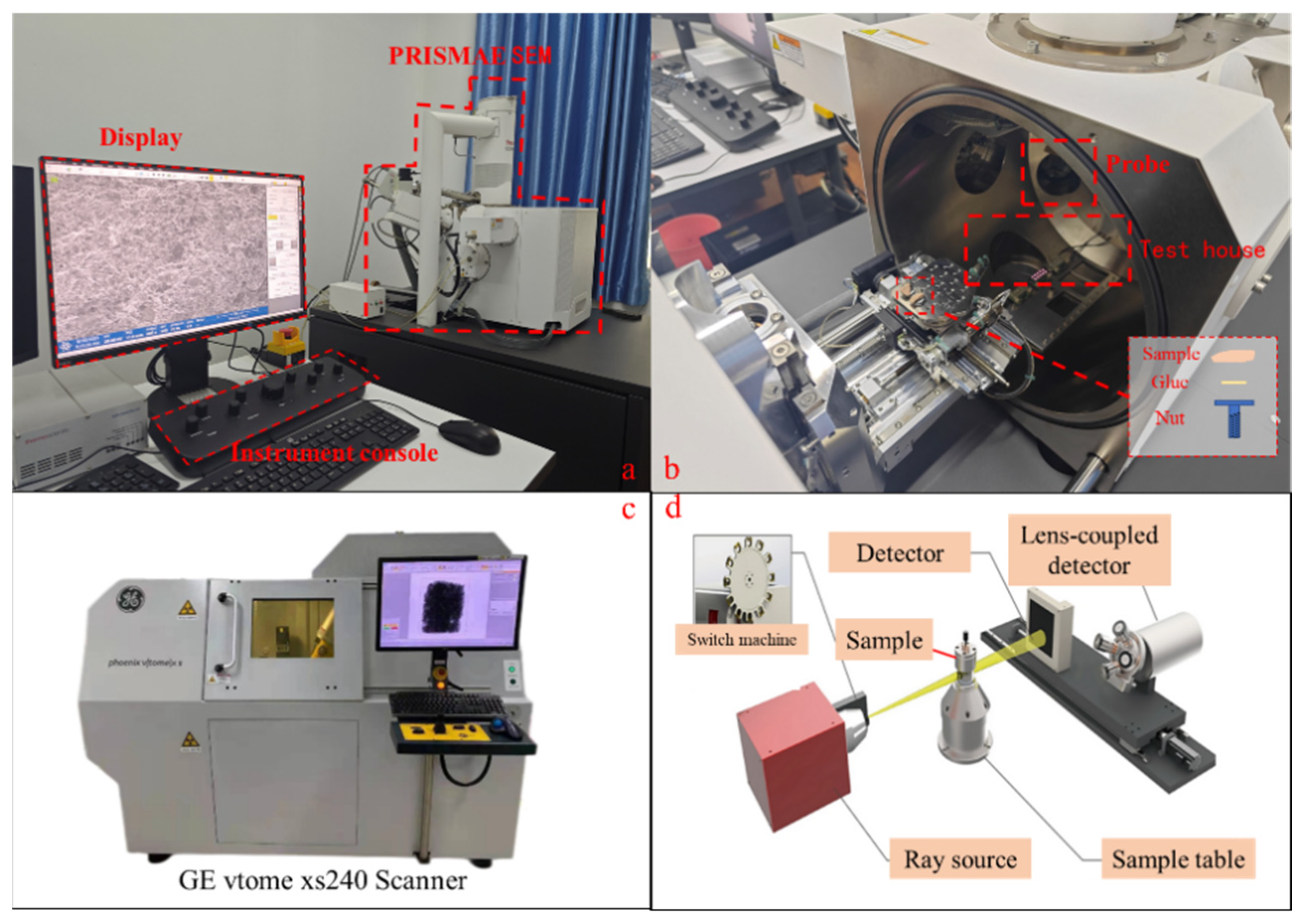



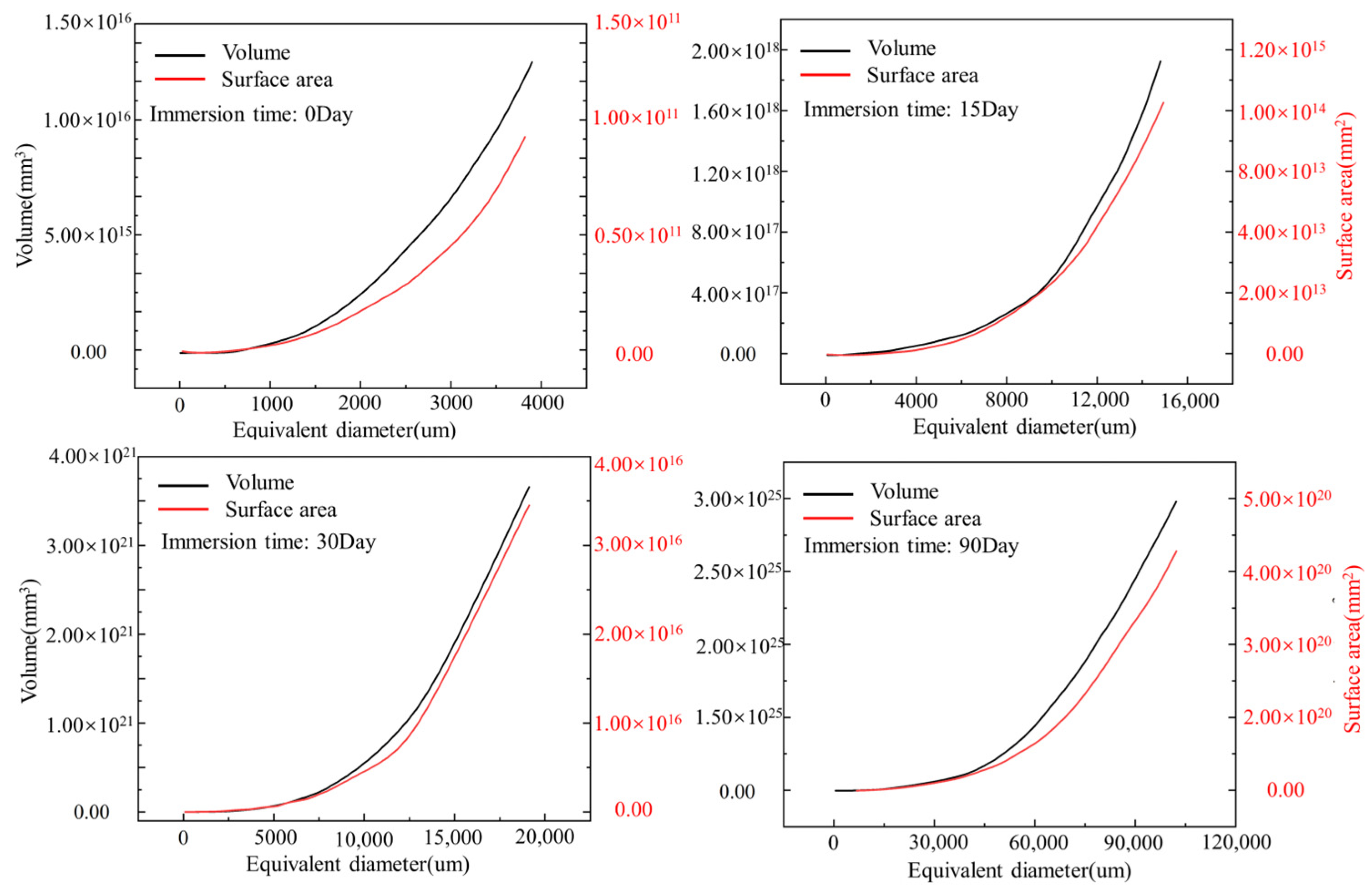
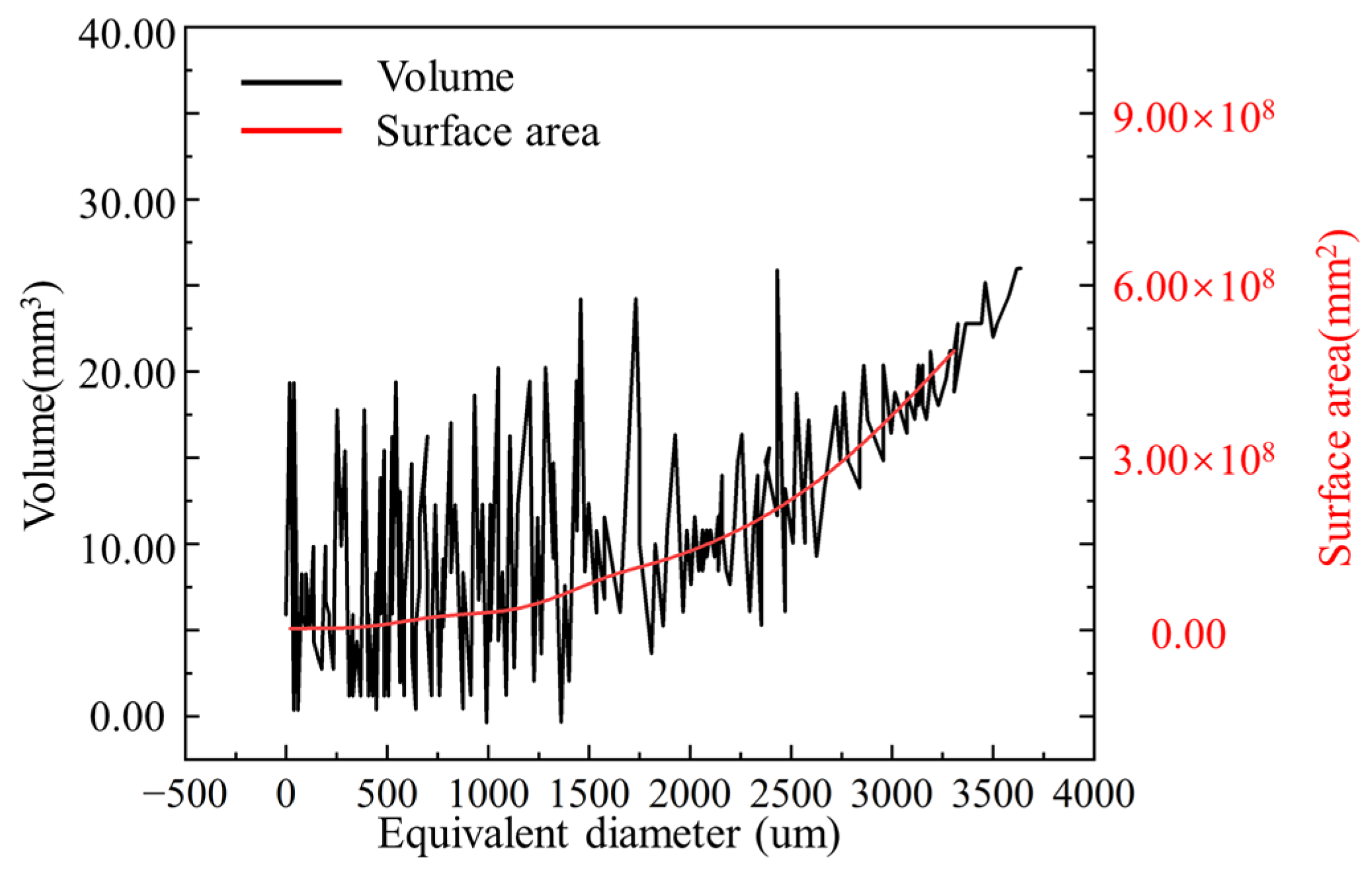
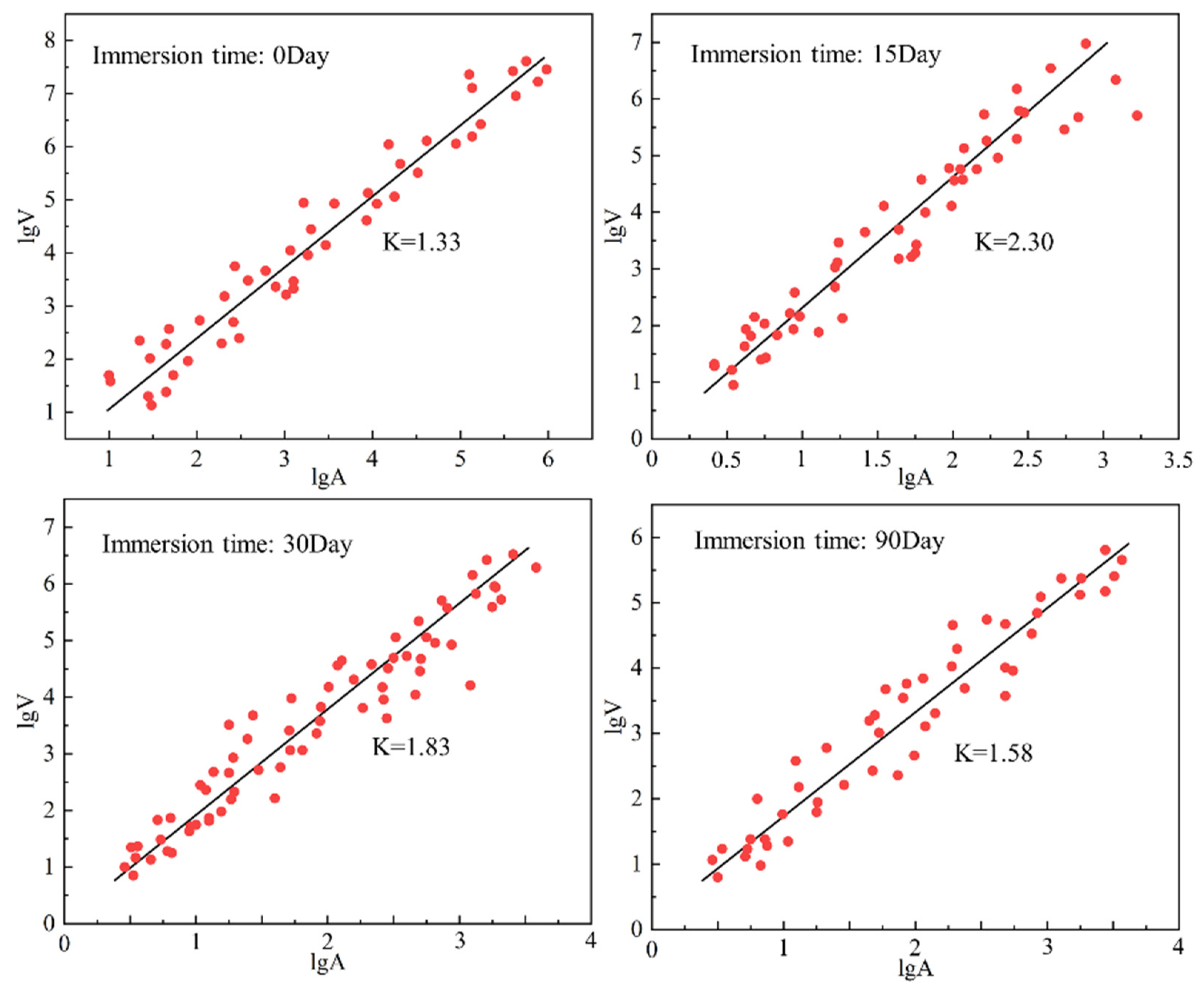
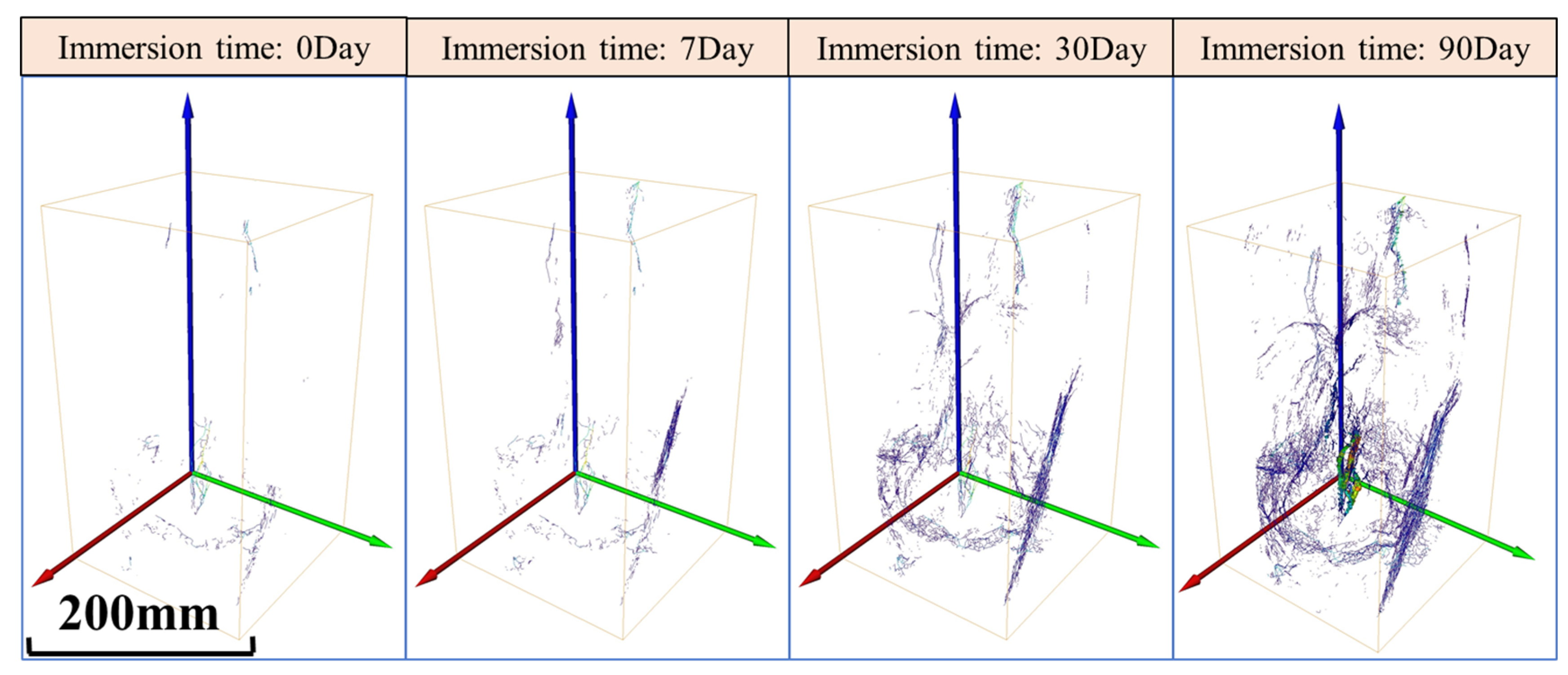
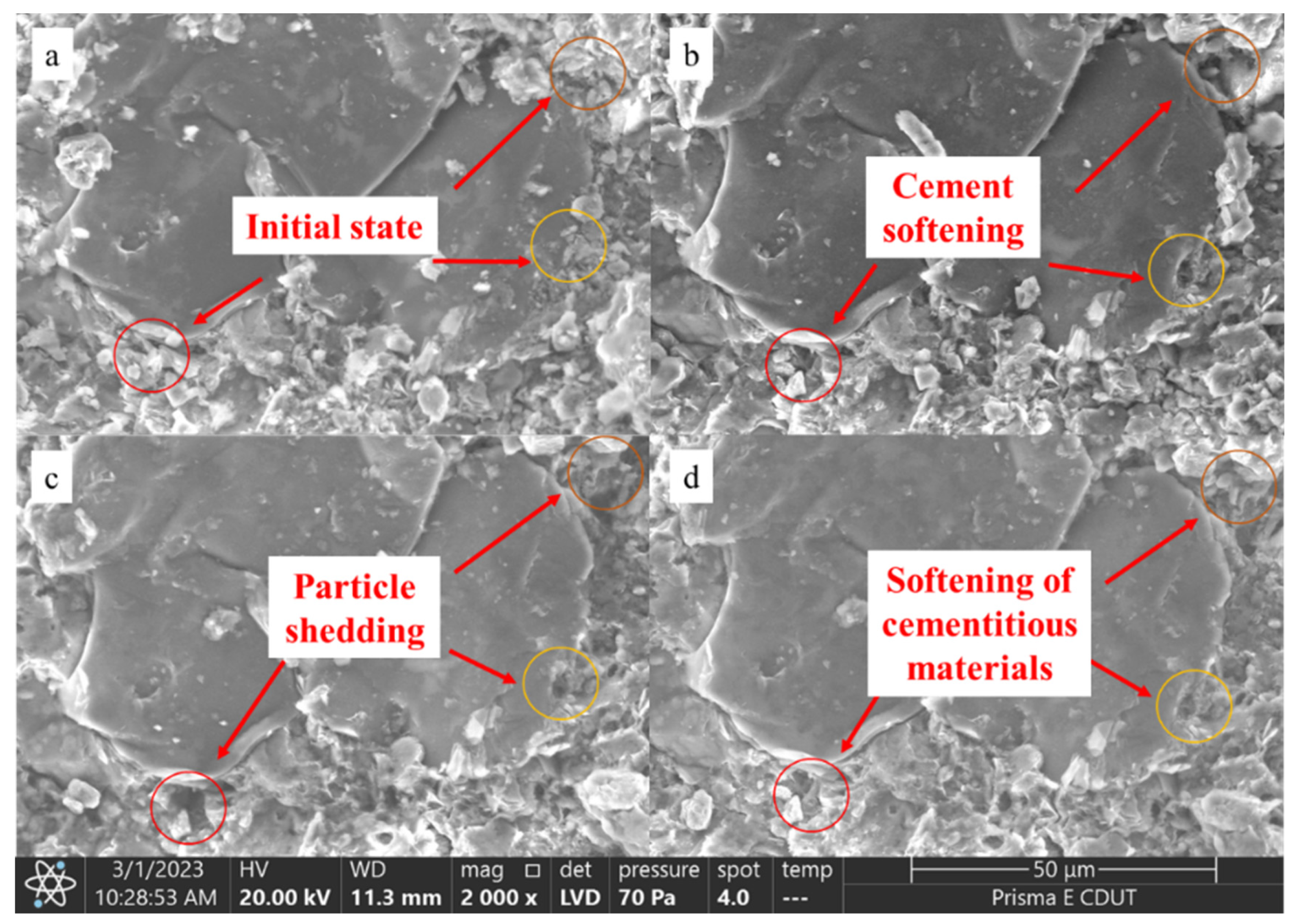
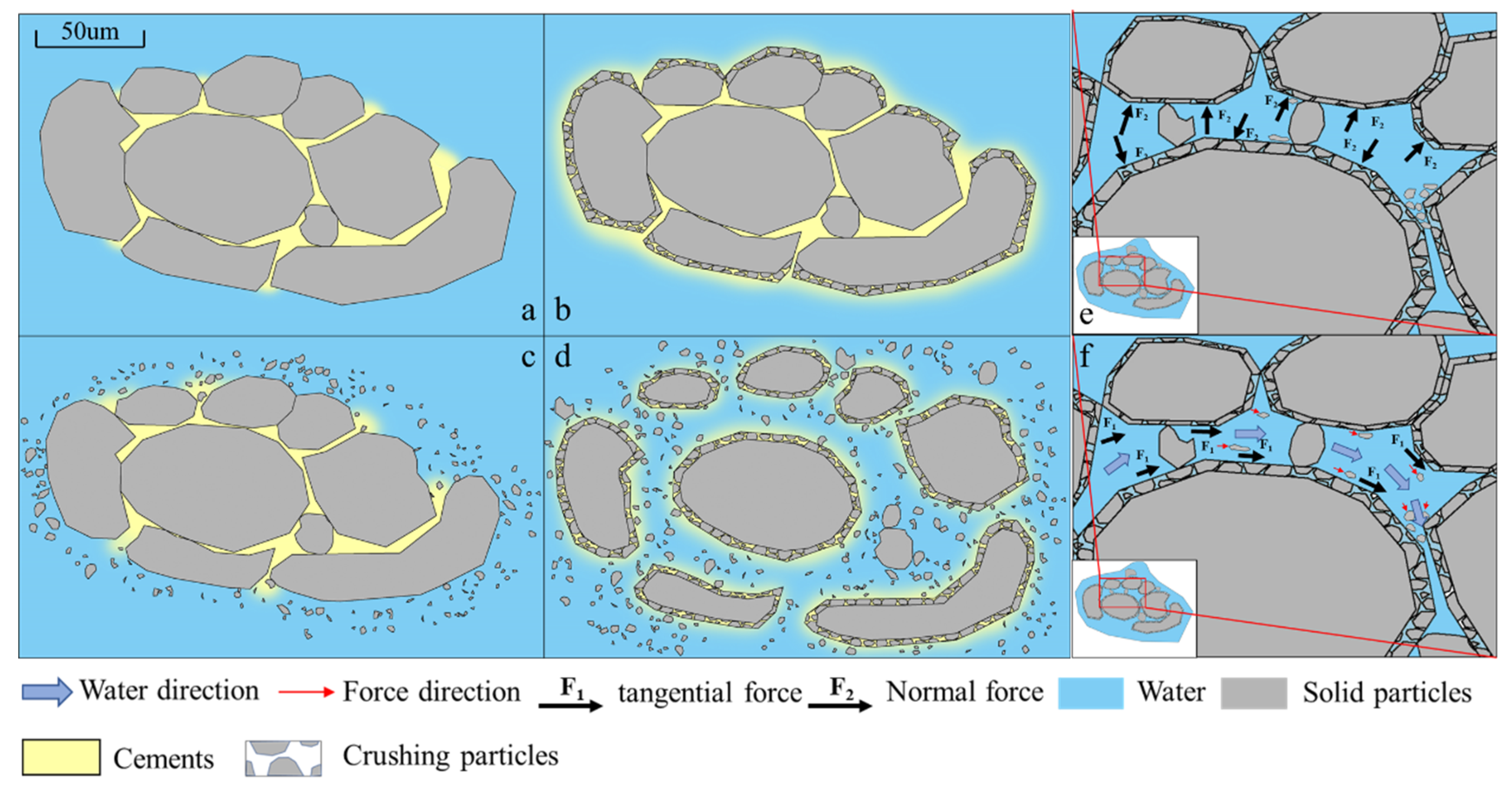

| Immersion Time | Si (µg·mL−1) | Al (μg·mL−1) | Fe (μg·mL−1) | Mg (μg·mL−1) | Na (μg·mL−1) | Ca (μg·mL−1) |
|---|---|---|---|---|---|---|
| 0 Day | 0 | 0 | 0 | 0 | 0 | 0 |
| 1 Day | 0.2 | 0.21 | 0.02 | 0.02 | 0.03 | 0.11 |
| 3 Days | 1.08 | 0.56 | 0.08 | 0.10 | 0.12 | 0.12 |
| 7 Days | 1.62 | 0.88 | 0.11 | 0.15 | 0.18 | 0.21 |
| 15 Days | 2.18 | 1.12 | 0.14 | 0.16 | 0.20 | 0.29 |
| 30 Days | 2.25 | 1.22 | 0.15 | 0.22 | 0.26 | 0.33 |
| 90 Days | 2.76 | 1.53 | 0.19 | 0.26 | 0.33 | 0.40 |
| Immersion Time | Fractal Coefficient | 3D Fractal Dimension |
|---|---|---|
| 0 Day | 2.30 | 1.34 |
| 7 Days | 1.33 | 2.25 |
| 30 Days | 1.58 | 1.89 |
| 90 Days | 1.83 | 1.64 |
| Element | Dc | r/(cm) | C1/(µg·mL−1) | C0/(µg·mL−1) | R2 |
|---|---|---|---|---|---|
| Al | 0.25 | 5 | 1.8 | 1.5 × 10−13 | 0.9932 |
| Ca | 0.26 | 0.5 | 2.46 | 1.07 × 10−18 | 0.9751 |
| Fe | 0.29 | 5 | 2.28 | 1.35 × 10−11 | 0.9887 |
| Mg | 0.24 | 5 | 0.3 | 1.52 × 10−17 | 0.9764 |
| Na | 0.25 | 7.4 | 1.74 | 2.02 × 10−14 | 0.9812 |
| Si | 0.24 | 3.6 | 3.42 | 2.19 × 10−2 | 0.9928 |
Disclaimer/Publisher’s Note: The statements, opinions and data contained in all publications are solely those of the individual author(s) and contributor(s) and not of MDPI and/or the editor(s). MDPI and/or the editor(s) disclaim responsibility for any injury to people or property resulting from any ideas, methods, instructions or products referred to in the content. |
© 2024 by the authors. Licensee MDPI, Basel, Switzerland. This article is an open access article distributed under the terms and conditions of the Creative Commons Attribution (CC BY) license (https://creativecommons.org/licenses/by/4.0/).
Share and Cite
Zhou, H.; Zheng, D.; Liu, J.; Yin, R. Fractal Characterization of the Microstructure of Red-Bed Soft Rocks and Kinetic Modeling of Interfacial Evolution. Appl. Sci. 2024, 14, 4458. https://doi.org/10.3390/app14114458
Zhou H, Zheng D, Liu J, Yin R. Fractal Characterization of the Microstructure of Red-Bed Soft Rocks and Kinetic Modeling of Interfacial Evolution. Applied Sciences. 2024; 14(11):4458. https://doi.org/10.3390/app14114458
Chicago/Turabian StyleZhou, Hongke, Da Zheng, Jiangfan Liu, and Ruiqi Yin. 2024. "Fractal Characterization of the Microstructure of Red-Bed Soft Rocks and Kinetic Modeling of Interfacial Evolution" Applied Sciences 14, no. 11: 4458. https://doi.org/10.3390/app14114458
APA StyleZhou, H., Zheng, D., Liu, J., & Yin, R. (2024). Fractal Characterization of the Microstructure of Red-Bed Soft Rocks and Kinetic Modeling of Interfacial Evolution. Applied Sciences, 14(11), 4458. https://doi.org/10.3390/app14114458





